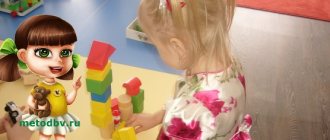Features of cognitive activity of preschool children
Attention! The most important function in the formation of a child’s cognitive activity is perception.
All the fundamental principles for the further development of the human psyche are built on this basic feature. Thanks to this function, the preschooler is able to navigate the world around him. Perception develops in a playful way - put together a beautiful puzzle, make a multi-colored pyramid, arrange triangles into molds, and so on.
From one to three years
By selecting parts of figures by color, shape, size and other characteristics, combining and comparing them with each other, the child receives practical application of the acquired knowledge.
Naturally, a child cannot achieve an ideal result right away.
To some extent, due to fairly serious errors, the correct result is formed.
Approximately closer to two years, the number of actions performed decreases.
Now visual perception begins to play a role - the correctness/incorrectness of a particular movement is determined by eye.
At the same time, thinking also develops along with perception. A kind of logic appears. So, in order to get the ball from the table, you should move a chair towards it, stand on it, and then take the ball. While pouring flour into the seeder, he realizes that it is falling out through the holes.
Thanks to this, the child begins to open new horizons with great zeal.
Rolling, rolling and sliding - these skills are also formed in the process of active mobile activity.
Thus, upon reaching the age of three, the child is able not to waste extra time on experiments, but to turn it all over in his head, envisioning positive or negative versions of the action.
In addition to independently studying the world around him, the child learns information that interests him from adults. Why does the dog bark? It's a cat? Is your aunt smiling? Is sand falling? Etc.
Thus, based on interaction with the world and communication with others, the baby develops his cognitive function and receives information about life around him.
At the age of 3 – 5 years
The nature of the child’s cognitive activity becomes more pronounced:
- Knowledge about the world is obtained more fully.
- New means of orientation in the world have been identified.
Figurative thinking and the ability to understand various symbols appear. A phenomenon arises, in addition to perception, as sensation. Visual acuity improves, phonetic hearing increases. But at the same time, fantasy is not yet fully developed; the child is a realist. What I see exists. What I don’t see is not there. Curiosity begins to develop with greater force, the child asks more and more “why?”
By 5–6 years
Intelligence begins to develop, the ability to model and experiment appears. The preschooler begins to carry out experiments on his own.
Cognitive development of a preschooler
The active involvement of a preschool child in various types of activities, expanding the range of his relationships with adults and peers contribute to the rapid development and improvement of many mental cognitive processes. (Aseev, S. 68)
This applies, in particular, to sensory development, i.e. development of sensations, perception and figurative representation.
The sensory development of a preschooler includes two interrelated aspects - 1) the assimilation of ideas about the various properties and relationships of objects and phenomena and 2) the mastery of new actions of perception and sensation, which make it possible to perceive the world more fully and comprehensively. (Mukhina, S. 222)
Revealing the essence of the first side of sensory development, it is necessary to understand that in preschool age there is a transition from the use of the child’s own sensory experience (this figure is like a “house”) to the use of generally accepted sensory standards - these are ideas developed by humanity about the main varieties of each type of properties and relationships, - colors, shapes (this figure is a triangle, and before it was a “house”), the size of objects, their position in space, the pitch of sounds, the duration of periods of time, etc. (Mukhina, S. 222)
In the first half of the period, the child begins to master the generally accepted means of performing the actions of perception and visual-figurative thinking - sensory standards and visual models (identifying and displaying connections and relationships between objects and phenomena in a visual form).
So, at 3 years old, a child knows what “color” is and is oriented in sounds (height, longitude);
4 years - knows the shape, and in the 5th year begins to visually dissect the shape of objects into given parts (this is facilitated by applique and construction from cubes);
5 years - children have a good understanding of colors, geometric shapes, relationships of 3-4 sizes (big, small, largest, smallest).
However, the most difficult thing for children is to master the standards of size, because they do not have a good command of the system of measures. At the same time, perception at this age also has imperfections: 1) children do not take into account a number of properties of objects or take them into account incorrectly. This is due to the fact that clear ideas are formed only about the main types of properties, which is why little-known properties are equated by the child with known ones. For example, having an idea of a square, a child may perceive unknown trapezoids and rhombuses as squares; 2) children find it difficult to consistently examine (for example, inspect) objects and objects and randomly jump from one figure to another.
But by the age of 6, the child already knows how to systematically and consistently examine objects, can describe their properties, guided by sensory standards, using only visual perception.
So, the assimilation of sensory standards is only one aspect of the development of a child’s orientation in the properties of objects.
The second side, which is inextricably linked with the first, is the assimilation of new and improvement of existing perception actions, or perceptual actions.
The development of perceptual actions takes place in 3 stages:
Stage 1
, when the process of their formation begins with practical, material actions performed with unfamiliar objects. To more successfully and quickly pass this stage, it is advisable to offer sensory standards for comparison. This is the stage of external perceptual actions;
Stage 2
— sensory processes themselves, restructured under the influence of practical activity, become perceptual actions. These actions are now carried out with the help of appropriate movements of the receptor apparatus and anticipate the implementation of practical actions with perceived objects;
Stage 3
occurs when perceptual actions become even more hidden, collapsed, reduced, their external links disappear, and perception from the outside begins to seem like a passive process. In fact, this process is active, occurring in the consciousness and subconscious of the child. As a result, external perceptual action turns into internal mental action. (Nemov, P. 84)
The assimilation of perceptual actions leads to the development of other abilities.
Thus, internal actions of perception , but if problems arise that the child cannot solve only with the help of internal actions of perception, then the child returns to external actions.
In older preschool age, orientation in space and time develops, and throughout the entire preschool age a general pattern applies: ideas about objects and their properties are formed earlier than ideas about space, and orientation in space precedes orientation in time (and is easier for the child) . Under the guidance of an adult, the preschooler forms the following concepts: -left/right- (using his right hand, the child determines the location of other objects: for example, a child can find out where his right eye is by focusing on his right hand); -between-, -in front-, -near-, -above, under, inside, near-, etc. It is important that pairwise relations (for example, -over/under-) are learned simultaneously, because it is easier for a child to understand. Certain difficulties in mastering these relationships are associated with the egocentric position of the preschooler.
Attention
. During the preschool period, attention, due to the complication of children's activities and their progress in general mental development, acquires greater concentration and stability.
The main change in attention in preschool age is that children for the first time begin to control their attention, consciously direct it to them, i.e. attention becomes voluntary. It is important to know that voluntary attention cannot develop on its own, but is formed through the inclusion of a child by an adult in new activities (drawing, designing, reading to a child).
At the first stages of mastering voluntary attention, it is difficult for children to control it. Therefore, reasoning out loud helps in developing the ability of voluntary attention. This has been proven experimentally. If a child is asked to constantly talk about what he should keep in the sphere of attention, then he will be able to voluntarily control attention for much longer than without speaking out loud.
Thus, voluntary attention is formed in connection with the general increase in the role of speech in regulating the child’s behavior. (Mukhina, S. 254)
However, it must be borne in mind that involuntary attention remains predominant throughout preschool age.
Memory development
. Preschool age is characterized by intensive development of the ability to remember and reproduce.
The memory of a preschooler is mainly involuntary in nature; memorization and recollection occur regardless of the will and consciousness of the child. The child remembers what he noticed in the activity, what impressed him, what was interesting to him. Consequently, in younger preschoolers, involuntary visual-emotional memory dominates.
Normally developing children of primary and middle preschool age have well-developed immediate and mechanical memory. These children easily reproduce what they saw and heard, but provided that it aroused their interest, and the children were interested in remembering it. Thanks to this memory, speech improves well, children learn to use the names of household items, etc. (Nemov, P. 87)
In middle preschool age, voluntary forms of memorization begin to take shape, and in older preschool age, they begin to improve. This process occurs most successfully in gaming activities, when memorization is the key to successful fulfillment of the assumed role.
Mastering voluntary memory goes through 2 stages:
1) at the first, the child emphasizes only the task itself of remembering and recalling, without yet mastering the techniques. In this case, the task to remember is highlighted earlier, because those around them often demand that the child reproduce what he did before; 2) the task of remembering arises as a result of the experience of remembering, when the child realizes that without remembering, he will not remember.
Adults teach a child voluntary memory techniques, for example, by asking him questions: “What happened then?”, “What else did you learn?”
It should be noted that although voluntary memory in preschoolers is already developed, involuntary memorization, associated with the active mental work of children on certain material, remains much more productive than voluntary memorization of the same material.
In preschool age, some children develop a special type of visual memory - eidetic memory - this is a very vivid and distinct memory based on reproduced images, which manifests itself in the fact that the child seems to again see in front of him what he is talking about. However, eidetic memory is an age-related phenomenon and is subsequently lost.
The memory of a preschooler, despite its imperfections, actually becomes the leading function, taking a central place among other mental processes. (Mukhina, pp. 254-257)
Imagination
the child is connected in its origins with the sign function of consciousness emerging in early childhood, i.e. symbolic function. The symbolic function receives further development in play activities, where symbolization is one of the structures of the game. (Nemov, P. 88)
In the first half of preschool childhood, the child’s reproductive imagination predominates, mechanically reproducing previously received impressions in the form of images. For example, a child is riding a stick, and at that moment he is the rider, and the stick is the horse. But he cannot imagine a horse in the absence of a horse-like object suitable for “riding,” and he cannot transform a stick into a horse until he actually rides it.
Gradually, internalization occurs - a transition to a playful action with an object that in reality does not exist, but is represented in the mind (a stick, like a horse, is no longer needed, because it is represented in the mind). This moment is the origin of the process of imagination as a mental process. (Mukhina, S. 258)
In older preschool age, imagination turns from reproductive to creatively transformative. It connects with thinking, beginning to perform a cognitive-intellectual function, and becomes controllable.
In addition to this function, imagination also has an affective and protective role. Thanks to the cognitive function of imagination, the child learns better about the world around him and solves the problems that arise before him more easily and successfully. The affective-protective role of imagination is that through an imaginary situation, tension can be discharged and a unique, symbolic resolution of conflicts can occur, which is difficult to achieve with the help of real practical actions. This function is the basis for relieving a child’s anxiety and fears with the help of training sessions. (Nemov, P. 89)
Thinking
. Role-playing games stimulate the development of another important process - thinking, primarily visual-figurative, the level of development of which is influenced by the degree of development of imagination.
In preschool childhood, the following main lines of thinking development are distinguished: 1) further improvement of visual and effective thinking based on the developing imagination; 2) improvement of visual-figurative thinking based on voluntary and indirect memory; 3) the beginning of the active formation of verbal-logical thinking through the use of speech as a means of setting and solving intellectual problems; 4) another striking feature of the thinking of a preschooler is that it is at this age that the cognitive orientation of thinking first appears. This feature is manifested in the child’s endless questions to the adult.
However, we must remember that the main type of thinking of a preschooler is figurative thinking (the result is obtained in the mind).
A child’s verbal and logical thinking, which begins to develop at the end of preschool age, already presupposes the ability to operate with words and understand the logic of reasoning.
The development of verbal and logical thinking in children goes through 2 stages:
1) the child learns the meanings of words related to objects and actions, learns to use them when solving problems;
2) the child learns a system of concepts denoting relationships and learns the rules of logical reasoning. The latter already applies to the school period.
The development of the internal plan of action, characteristic of logical thinking, takes place in 6 stages (N.N. Podyakov. Reader on developmental and educational psychology. Part 2, 1981) from younger preschool age to senior:
1. The child, using his hands, manipulating things, solves problems in a visual and effective way.
2. In solving a problem, the child includes speech, not only to name the objects with which he manipulates in a visually effective way. The main result is obtained by hand.
3. The problem is solved figuratively through the manipulation of object representations. An elementary form of reasoning aloud arises, not yet separated from the performance of real practical action.
4. The child solves the problem according to a pre-compiled, thoughtful and internally presented plan. Its basis (plan) is memory and experience.
5. The problem is solved in terms of actions in the mind, followed by the implementation of the same task in a visually-effective plan, in order to reinforce the answer received in the mind and then formulate it in words.
6. Solving the problem and delivering the final result occurs entirely internally, without resorting to real actions.
Summarizing the conclusion from the scheme described above, it should be pointed out that in children the stages of mental actions and operations passed through do not disappear completely, but, being transformed, are replaced by new ones. In children's intellect, all 3 types of thinking are represented and, if necessary, simultaneously included in the work.
In preschoolers, the process of developing concepts also occurs, especially intensively when thinking and speech are combined with each other.
To understand the dynamics of the development of concepts, along with knowledge about the development of thinking, it is necessary to know the features of speech development in preschool age.
Development of cognitive abilities, activity and interest
Important! In order to fully develop the child’s cognitive abilities, special classes should be conducted. The most interesting thing at this age is play. Therefore, all information should be carried out in game mode.
On average, such a game should take no more than 15–20 minutes, so as not to cause rejection in the baby. During classes, you need to show everything by example: in which hand to hold a spoon, how to take off and put on clothes.
Reference! Children love to have fairy tales reread to them or a story told again. This way the child remembers information better.
You should not make excessive demands or scold your child for misunderstanding or poor assimilation of knowledge. Remember, this can only discourage you from doing anything. This is the wrong strategy. It is better to praise the preschooler for small successes and help correct shortcomings.
Exercises
1. From one to three years:
They use cubes, various figures (not too small, a child can swallow them), assembling puzzles, fashioning elementary figures from plasticine and role-playing games (seller - buyer, hairdresser - client, and of course, daughters - mothers).
2. Three to four years:
Learning the alphabet and reading by syllables, learning basic mathematical calculations (a bear plus a bear, how many bears?), reading children's books, talking about them (why is the queen evil?), modeling animals and plants from plasticine, creating crafts, collecting Legos, construction sets.
3. From four to five years:
Games for comparison, difference (which mosaic is missing, which picture is extra). The ability to distinguish colors, coordinate nouns and adjectives, etc. develops.
The role of an adult in the development of the cognitive sphere of a preschooler
It is important for parents to realize that their child’s cognitive sphere will be more effectively expanded and filled with the active participation of adults.
We recommend that you read:
- What should a 3 year old child be able to do?
- What should a 5 year old child be able to do?
In preschool childhood, the possibilities of knowledge practically know no bounds. The why child himself initiates many questions and increases his information base thanks to easy-to-understand answers. Active children gain knowledge through communication with adults and peers, as well as through experience, to the extent that those around them allow them to experiment and act.
But the peculiarities of the development of the cognitive sphere of a preschooler are such that mental processes aimed at cognition are to a greater extent involuntary. For comprehensive development, adults must direct the child’s attention, interest and activity. And this needs to be practiced not only in development classes, but also in everyday interactions with children.
Development of cognitive and research activities
From five to seven years of age, the cognitive activity of a preschooler begins to include research and experimentation.
You can take standard games (hide and seek) or play a game - find the hidden thing in the room, focusing on the “cold - hot” clues.
You should play the following educational game: several children take turns trying to explain the meaning of a word without naming it, the child must guess.
At preschool age, children learn to draw conclusions and conclusions, conduct experiments, through trial and error. It is very good at this time to develop creative abilities, form moral and moral values by showing high-quality cartoons and reading good books.
It is also important to pay attention to the child’s speech development. Practice on your own if you see any benefit in it, but when your child does not pronounce a certain letter for a long time or makes severe articulation errors, contact a speech therapist.
Neoplasms of preschool age
The development of the cognitive sphere leads the preschooler to new formations that take the personality to a new level. Neoplasms are the most important criteria that separate one age period from another and reveal its essence. In older preschool age, the meaningful acquisition is worldview and arbitrariness.
Formation of worldview
Gradually, connections are established in the child’s mind between everything he already knows about. Consequently, a primary worldview is formed. Psychological aspects such as the development of self-awareness and understanding of the system of relationships between people are also important.
The child's brain is able to detect certain patterns. An older preschooler already understands very well that actions and deeds lead to certain consequences, including moral and ethical ones.
The formation of a worldview as a mental new formation of preschool childhood is still quite schematic. This is a kind of outline that will begin to actively fill in as soon as the child goes to school.
Formation of arbitrariness
The main achievement of preschool age is the formation of arbitrariness. It is also a new formation that stimulates the development of the cognitive sphere. If a younger preschooler perceives, pays attention, thinks involuntarily - what attracts him more is what his cognition is directed towards - then in older preschool age, at least partially, this process can be controlled.
Arbitrary perception
Arbitrariness ensures the perception of the information that an adult presents to a child. Voluntary attention allows a preschooler to see and listen not only to what he wants, but also to what is necessary. Therefore, voluntariness is the most important “acquisition” for the cognitive sphere in the preschool period.



